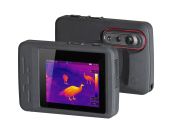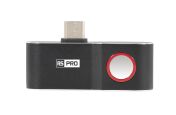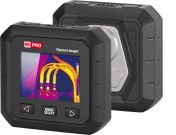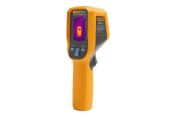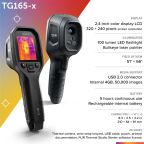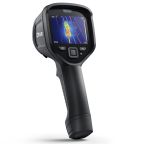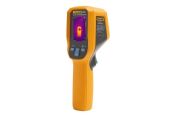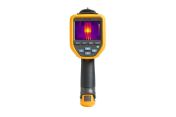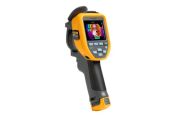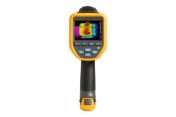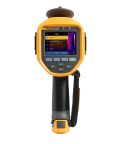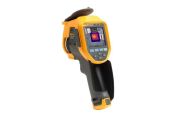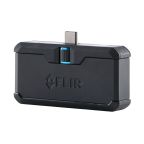Thermal Imaging Cameras
Thermal imaging cameras are handheld non-contact devices used to capture detailed images in low-light and hard-to-see environments. They do this by detecting infrared energy (heat) and converting it into an image. Portable thermal cameras are especially useful for troubleshooting, identifying potential hotspots, and ensuring machinery and equipment run correctly and efficiently. The ease of portability allows technicians to easily carry and use them across various locations, making them ideal for fieldwork and on-site inspections.
RS offers a range of high-performance, state-of-the-art thermal imaging cameras and measurement equipment from industry-leading brands, including FLIR, Fluke, Testo, Hikvision, Keysight, and of course RS PRO. RS also offers a calibration service if required. See more about our calibration services.
How Does Thermal Imaging Cameras Work?
Thermal imaging cameras are point-and-shoot devices that enable the user to see real-time in an infrared spectrum, interpreting temperature as color. Warmer areas appear as red and yellow, and cooler areas as purple or blue. These cameras excel in their ability to detect and capture infrared energy, which is invisible to the human eye. By focusing on infrared energy, they can reveal temperature variations across surfaces and objects, providing valuable insights into thermal patterns and anomalies. Infrared thermal imaging cameras use an external lens to focus infrared energy to an internal thermal sensor. The sensor, along with processing electronics, convert the heat and use the captured data to create images. Images can be used for immediate diagnosis or can be stored and processed through dedicated software for further evaluation.
Types of Thermal Cameras
- Handheld Thermal Imaging Cameras: These cameras are designed to be portable and easy to use, allowing users to carry them around for on-the-go thermal inspections. They are commonly used in various industries for tasks such as building inspections, electrical maintenance, HVAC troubleshooting, and firefighting.
- Smartphone-Integrated Thermal Cameras: These thermal cameras are designed to be attached to smartphones, utilizing the phone's display and processing power. They offer portability and convenience, allowing users to transform their smartphones into thermal imaging devices. Smartphone-integrated thermal cameras are often used for home inspections, outdoor activities, and DIY projects.
- High-Performance Thermal Cameras: High-performance thermal cameras are designed for professional use in demanding environments. They offer advanced features such as higher thermal resolution, extended temperature ranges, faster frame rates, and enhanced image processing capabilities. These cameras are commonly used in research and development, industrial inspection, security surveillance, and scientific applications where accuracy and reliability are crucial.
- Specialized Thermal Cameras: Specialized thermal cameras are tailored for specific applications or industries. They may have unique features optimized for tasks such as medical imaging, veterinary diagnostics, predictive maintenance, gas detection, or firefighting. These cameras are designed to meet the specific requirements and challenges of their respective fields, providing specialized functionality and performance.
What Do Thermal Imaging Cameras Detect?
Any object with a temperature above zero will give off thermal energy. The hotter an object is, the more thermal energy will be emitted. So, essentially thermographic cameras can detect anything that produces a heat signature.
In electrical inspections and industrial settings, thermal imaging scanners are crucial for identifying issues such as overheating components and faulty connections. For example, during an electrical inspection of a distribution panel in an industrial facility, thermal scanner guns can detect hotspots caused by excessive resistance or loose connections. These hotspots, depicted as areas emitting high thermal energy, indicate potential faults or impending failures. By capturing thermal images of the distribution panel, thermal imaging scanners enable technicians to proactively identify and address issues before they escalate into costly downtime or safety hazards. This application demonstrates how thermal imaging scanners or thermal scanner guns play a vital role in ensuring the reliability and safety of electrical systems in industrial environments.
What Are Thermal Cameras Used For?
The possibilities are endless! Thermal cameras were originally developed for military and surveillance operations, but now their useful technology enables the cameras to be used in a wide range of other applications. Some of the most common are:
- Electrical Engineering: Used to identify hotspots in electrical enclosures. Engineers can detect potential equipment failures caused by equipment overheating.
- Fire Service: Firefighters use thermal imagers to see through smoke and localize fire hotspots.
- Automotive Industry: Mechanics use thermal imaging cameras for engine diagnostics.
- Medical: Doctors, nurses and vets can use cameras to detect fevers in human’s temperature or temperature differences in animals.
- Construction: Building inspectors use cameras and thermal images for checking insulation and for detecting leaks in heating systems.
Professional-grade thermal imaging cameras offer superior resolution and temperature range tailored for demanding applications in various industries. These advanced scanners are equipped with high-quality sensors and optics, ensuring precise and detailed thermal images. With higher resolution, professionals can capture finer details and detect subtle temperature variations, allowing for more accurate analysis and diagnosis of thermal anomalies.
Professional-grade cameras also boast extended temperature ranges, enabling them to detect both extreme heat and subtle changes in temperature with precision. Whether used in electrical inspections, building diagnostics, industrial maintenance, or research and development, professional-grade thermal imaging cameras provide professionals with the tools they need to conduct thorough assessments and make informed decisions. Their enhanced capabilities make them indispensable assets for professionals seeking reliable and comprehensive thermal imaging solutions.
How Much Do Thermal Cameras Cost?
The price range of thermal cameras varies depending on several factors, including the brand, model type, and availability of regional suppliers. Premium brands often offer higher-end models with advanced features, leading to a higher price range compared to entry-level or mid-range options. Additionally, the specific model type, such as handheld devices, smartphone-integrated cameras, or high-performance units, also influences the price range. The availability of regional suppliers can also affect pricing due to factors like import taxes, distribution costs, and local market demand. In the Philippines, thermal camera prices may vary based on these factors, with a wide range of options available to suit different budgets and requirements.
Buy Thermal Imaging Camera in Philippines
Looking to buy a thermal imaging camera or scanner gun in the Philippines? Look no further than RS. With a wide range of portable or industrial thermal scanner options available, we have plenty of choices to suit your needs. Buy thermal imaging cameras online from a trusted supplier today!
Popular Searches
Related links
- Fluke Thermal Imaging Camera Infrared Lens for Use with TiX1060 Thermal Camera
- FLIR Thermal Imaging Camera Thermal Imager Visor for Use with E30bx
- Fluke Thermal Imaging Camera Thermal Imager Visor
- Fluke Thermal Imaging Camera Thermal Imager Visor for Use with Ti200 Ti400
- Everything You Need To Know About Thermal Imaging Cameras
- Fluke Thermal Imaging Camera Infrared Lens for Use with TiX875 and TiX870 Thermal Imager TiX885
- FLIR Thermal Imaging Camera Infrared Lens for Use with E75 E95
- FLIR Thermal Imaging Camera Infrared Lens for Use with FLIR Exx Series and T500-Series Cameras

